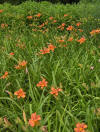WILD
FOODIES' HOME PAGE
PLANT PROFILE LIST
NAME: Day Lily
SPECIES / FAMILY: Hemerocallis Fulva / Asphodelaceae
OTHER COMMON NAME(S): tiger lily
CONDITIONS: sun
|
PARTS: |
EDIBLE |
TASTE |
RAW/COOK |
SEASON |
|
All |
|
|
|
|
|
Shoots |
|
pepper/celery |
RAW/COOK |
Spring |
|
Leaves |
|
COOK |
Spring |
|
|
Stalk/Stem |
|
|
|
|
|
Buds |
pea |
RAW/COOK |
Summer |
|
|
Flowers |
|
|
COOK |
Summer |
|
Fruits |
|
|
|
|
|
Pods |
|
|||
|
Seeds |
|
|
|
|
|
Nuts |
|
|
|
|
|
Roots |
|
nutty |
COOK |
Fall |
|
Bark |
|
|
|
|
PORTION: small
COMMENT: The best time to eat is in the early spring when the shoots are young, but be sure to identify (wild only, not hybrids) and prepare correctly. Daylilies can give a weird back taste, so it might be best to boil roots, shoots, and stalk and throw off the water once. // "The leaves need to be eaten whilst still very young since they quickly become fibrous... The flowers can also be dried and used as a thickener in soups etc. In this case, they are picked when somewhat withered and closed. A rich source of iron. Flower buds can be dried and used as a relish. Young tubers are best, though the central portion of older tubers is also good.” (1)
CAUTION: To be on the safe side, dry and/or cook and stay with wild daylilies, not hybrids. “Large quantities of the leaves are said to be hallucinogenic. Blanching the leaves removes this hallucinatory component. (This report does not make clear what it means by blanching, it could be excluding light from the growing shoots or immersing in boiling water.)”(1) "The daylily, a standard plant in foraging for a century or more, has become too much of a good thing and now presents a significant seduction to the forager. Here is why: There are too many of them. While that would sound like a good thing, it isn’t because that has created uncertainty about edibility." (2) Can cause gastric distress if not properly identified and prepared -
NUTRITION/MEDICINAL: The dried flower contains about 9.3% protein. 25% fat, 60% carbohydrate (rich in sugar), 0.9% ash. It is rich in vitamin A. Also a: Anodyne; Anthelmintic; Antidote; Antiemetic; Antispasmodic; Blood purifier; Cancer; Depurative; Diuretic; Febrifuge; Laxative; Sedative.(1)
LOOK-A-LIKES: Cultivars and Tiger Lily.
POISONOUS LOOK-A-LIKES: Shoots and leaves of iris look very similar. https://en.wikipedia.org/wiki/Iris_(plant)
OTHER USES: “Weaving. The tough dried foliage is plaited into cord and used for making footwear. Plants form a spreading clump and are suitable for ground cover when spaced about 90cm apart each way. The dead leaves should be left on the ground in the winter to ensure effective cover. The cultivar 'Kwanso Flore Pleno' has been especially mentioned.”(1)
SOURCE LINKS (may include nutritional and medicinal info, plus other uses):
- https://pfaf.org/user/plant.aspx?LatinName=Hemerocallis+fulva
- https://www.eattheweeds.com/daylily-just-cloning-around-2
- https://en.wikipedia.org/wiki/Hemerocallis_fulva
- http://www.foragingtexas.com/2008/08/day-lily.html (good photos)
-
https://eattheplanet.org/day-lily-an-ornate-and-versatile-edible
-
https://www.motherearthnews.com/organic-gardening/how-to-sustainably-harvest-daylilies-zbcz1307
- https://www.cbc.ca/life/food/daylilies-the-hardy-and-edible-summer-bloom-that-s-easy-to-find-1.5636595
- https://honest-food.net/dining-on-daylilies (recipes)
- https://chestnutherbs.com/delectable-daylily (recipes)
- https://cookforgood.com/how-to-eat-daylilies
- https://www.themeateater.com/wild-and-whole/forage/how-to-cook-daylilies



_v2_small.jpg)